Part 1: The sad story
I find I never fully relax during the Summer. Let me explain why. In Anne of Green Gables the main character comments that she never makes the same mistake twice (implying that she is always finding new mistakes to make). That seems to be my experience with mooring a 26’ Trimaran over the last three years or so. The Wood Islands harbour (Prince Edward Island, Canada) where I keep my boat is really a ferry dock with a separate area for fishing boats. From May into December the two ferries pass in and out of the harbour as often as every 90 minutes going to Nova Scotia some 20 miles away, and the approximately 20 fishing boats that call the harbour home travel out for two months six days a week at some insanely early hour and return around mid-day. The Lobster season ends before July 1, but fishing traffic continues at a reduced level through scallop season in October and November. In short, there is quite a bit of commercial traffic.
Season One
There have never been more than two sailing vessel calling Wood Islands home and no other pleasure vessels are seen except an occasional ramp-launched speedboat. An occasional passing sailboat spends the night at the wharf. Technically, having paid their fees, pleasure boats have the same rights in the harbour as commercial boats but, in the words of Scripture, “Make every effort to live in peace with all men…. (Heb. 12:14)” The first year I kept the boat tied up among the other boats.
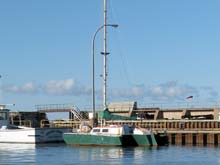 |
My 26' Trimaran at the ferry dock
click images for larger views |
There isn’t enough linear distance to fit all the boats along the wharf. The heavy 45’ fishing boats would not tie up outside my boat at the wharf for fear of crushing it, and tying my boat on the outer edge of a stack of several fishing boats would put me in the way every morning when they go out. Also, at the wharf I am fighting the abrasion of the tidal motion against the corrugated steel retaining walls that make up the docks (the same deep corrugations that swallow little fenders for breakfast).
Season Two
The second season, after being in the way wherever I tied up, I chose to join a nautically-experienced friend and moor just inside the mouth of the outer harbour.
| At the mooring |
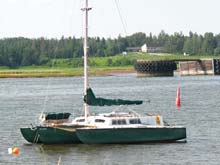 |
The best mooring area is along a relatively narrow strip between the deep channel used by the ferry and the shallows near the shore that can dry out at low tide.
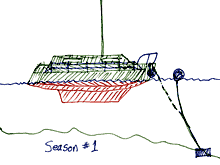 |
My first mooring setup |
I describe the details of getting and setting the mooring block in a later section. Mooring that second season involved catching a nylon line just below the buoy with a boat hook and then wrapping that line around a horn cleat at the bow.
| At the mouth of the harbour one trod a fine line between the deep channel used by the ferry and the shallows of the SE part of the harbour. |
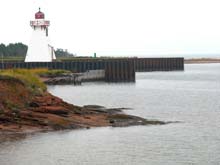 |
I show the general layout of the harbour in the diagram below. The cleating point of the mooring line had to be relatively short (“short scope”) or else the boat would swing out into the ferry channel or in to run aground at low tide. Since returning fishing boats almost never slow down in the outer harbour, there is a lot of tugging from waves over a season. In addition, while the mooring location is sheltered from south and east winds and has too little fetch to have waves build up from the north, a strong west wind along the Northumberland Strait at high tide can breach the western sand bar and let in large waves. Sometime during that summer the short line, when faced with a high tide and the surge from passing fishing boats, began lifting the mooring block and shifting it toward the channel.
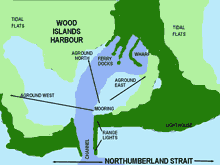 |
The general layout of the harbour |
Season Three
To avoid mooring block drift and variation in the scope depending where the line was cleated, my solution for the third season was to add a second block and shackle a chain to connect the two blocks together. Near the mid point, I shackled a bronze ring for centralized connections to the boat and the floats.
| My mooring setup for the second season |
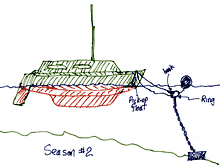 |
Mooring involved clipping a small snap hook to the ring. The hook was at the end of a nylon rope permanently cleated to the boat so there was no variation in the length of the mooring line.
About 10:30 on a dark, windy, rainy night, I had a pounding on my door and a local fisherman told me that my boat had broken loose and was being pounded on the eastern sand bar. Hurrying down I saw (by the car headlights) that in a few more hours high tide would be pounding the boat against the concrete erosion protection.
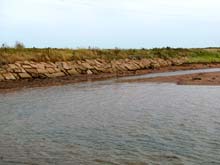 |
Rocks along the eastern shore. |
Four of us rescued the boat by having someone row a line out to it and then pulling it off the sand bar with a pickup truck. Investigation the next day revealed that the ring had disappeared and all the mooring components had gone their separate ways. The floats were easy to find along the shore but finding a 25’ chain in 10’ of muddy water was difficult.
A few weeks later, having restored the mooring floats and lines without the ring, in anticipation of another blow, I added extra protection to back up the mooring line (remember, I never make the same mistake twice!) by tossing out two anchors. Several days later Loren Panting at the auto repair garage asked me if I knew my boat was over on the west side of the harbour. Oh no! By the time I heard of all this, it was calm. Rowing across to the west, I boarded the boat and found that the nylon mooring rope permanently attached to the boat had rubbed through where it came over the edge of the boat (despite a protective chafe guard). In addition, I had not bothered to set the two anchors and, in the strong east wind, the boat must have dragged the anchors along the bottom until they finally caught in the shallows on the west edge of the harbour! Subsequently the wind had reversed and pulled the (Danforth-type) anchors out, seriously bending the shaft on one. Fortunately the second anchor re-caught and kept the boat from wandering back to the east side of the harbour! Since it was the line on the boat that parted, all the mooring itself (including the buoys!) was still right where it belonged.
Season Four
This year, to give redundancy, I set the second mooring block with separate chain to hold the stern in place and keep the boat from twisting around the mooring with wind and tide reversals.
| Mooring blocks |
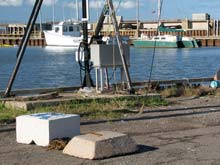 |
I also installed strong U-bolts at the bow and the stern to take the mooring connections.
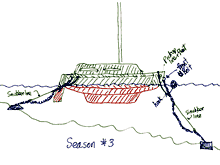 |
Using the second mooring block |
Mooring was complicated. While there was now a pickup line between the primary float and a small float at the end of the line, making the stern connection usually required rowing over to the stern float and line and bringing them over to the boat. Then someone had to haul on the line to swing the stern to the correct orientation before making the connections. However, with both a chain connection and a backup rope connection from the pickup lines, there was lots of redundancy!
Imagine my dismay this fall to get a 6:30 AM call from the ferry terminal reporting that my boat had drifted into their channel and would I please take care of it? Sure enough, with a strong south wind the boat was almost running into one of the ferries.
| The North shore |
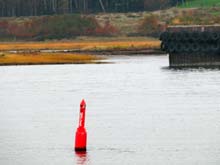 |
Rowing out in the dinghy again with wind and waves, I boarded and found that the both mooring connections to the boat were intact. The redundant connections to the boat had held. But the primary mooring connection shackle, just up from the concrete block had apparently lost its pin. I had swapped blocks with my nautical friend, and I suspect he had held the shackle pin with black tape rather than stainless wire and it had worked loose over two seasons—the block had not been pulled up over the winter and was never checked. The second, lighter mooring block was still fastened to the stern. Apparently, that block had never really settled into the firmer bottom in the shallows. When the connection to primary block lost its pin, the force of the wind must have been too strong and the lighter block must have dragged across the shallows and across the deep channel, catching up on the far side just beyond the ferry. I could not winch the block up because the chain links caught on the deck edge. (Besides, if the block came lifted off the bottom, the still-present wind would drive me on shore.) After calling the coast guard to get a fishing boat to come out for me, my rescuer radioed asking if I could simplify the rescue process by detaching the mooring block and leaving it with a float as a marker. Duh! Once I unhooked the mooring block, it was a simple matter to motor unaided over to the wharf and tie up. A week later, on a calm day, fully prepared with ropes and hooks to attach to the chain, I went back to retrieve the mooring block. During that week though, wind or tide shifts had thoroughly twisted the chain from my block around the chain holding a channel marker! When I began to motor toward the wharf the marker insisted on following me. I wasted an entire morning struggling to winch the (now two) mooring blocks up to 8’ depth so they would clear the shallower channel bottom and I could drag them over to the crane. When I pulled the mess out of the water, I found I had been fighting well over 1000 lbs of chain and concrete. Hanging over the wharf, it could be untangled and I left the channel marker for the Coast Guard to eventually reset.
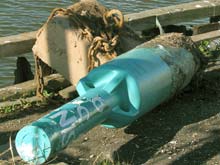 |
Channel buoy, mooring block and chain |
But I will probably never be able to find my primary block that may be buried in 1-2’ of mud with only a 2’ length of chain. In the “new mistakes” category is the fact that I never got around to recording the GPS coordinates of that block! At least the season was so far gone that I kept the boat at the wharf for the last few weeks of the sailing season before bringing it home. I will put out a new mooring system next Spring.
My anchoring skills also need work. The only overnight trip I took this year was with a college-aged friend who makes up for the declining strength in the ageing captain. We went about 20 miles to Murray Harbour with all sorts of adventures, but in the end, with pouring rain, we had to repeatedly tack into a strong head wind going up a narrow channel because the outboard motor was not working right. Coming up to anchor among moored boats, we dropped the Bruce-type anchor and let the wind push us back to set the anchor. With boats nearby, we kept the anchor line relatively short. Shuttled home in the car by my wife, we got the seats soaked, but at least there was a heater! Imagine our surprise, upon returning the next afternoon, to find that boat was nowhere to be seen. Conversations with people in the area revealed the boat had stayed put through several tides, but must have floated off to the east about an hour before we arrived. I finally saw about 2 miles away near the mouth of the river/harbour — almost going out to sea. Again with many adventures the errant boat was caught by a crew in the dinghy and motored back. We tied up to a sturdy unused mooring for safety and sailed home the next day.
Perhaps you can now better appreciate why I never seem to relax fully until the boat is sitting for the winter on its trailer in the yard!
Advice:
- Use a heavy mooring block and (for my relatively light boat—2800 lbs.) at least 3/8” chain which can take larger shackles. Smaller chain may be strong enough but cannot clear the really heavy shackles.
- Be sure to have some part of the connection flexible—a snubber or a good length of light nylon line.
- Always fasten shackle pins with stainless wire so they will not come unscrewed.
- Make sure a marker buoy is attached directly and separately to the mooring chain or line so there is a better chance of finding the block if connections fail.
- Never trust a chafe guard for an extended time. Always inspect all the line and reposition any potential chafe point.
- Use redundancy—have at least two connections to the boat and consider two mooring blocks. The second block can hold the stern of the boat as a separate connection or else can be chained directly to the first block with a mid-point connection.
- Flexing can fatigue bronze fittings.
- A swivel is good, not just to make the connections easier, but also to keep the chain from breaking due to twist—apparently a twisted chain is likely to break at a lighter force.
- Be sure to get the GPS position of any blocks—that may be your only hope of recovery.
- Buy a forehead-mounted flashlight so you can see what you are doing with both hands busy on a dark, windy night trying to rescue your boat
- Pull and inspect mooring blocks every season. This fits well with removing them over the winter if required by the harbourmaster.
Tom Schultz
schultz@pei.sympatico.ca
Tomorrow:
Part 2: Technical Details
***** |

